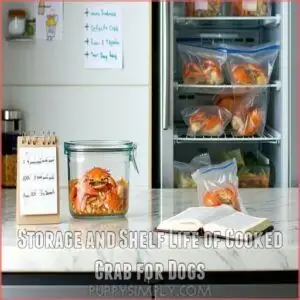This site is supported by our readers. We may earn a commission, at no cost to you, if you purchase through links.

Small amounts of cooked crab meat can be a healthy treat.
It’s packed with protein and good fats that can make your dog’s coat shine.
However, you can’t just toss them a whole crab.
Shells are a choking hazard, and raw crab can harbor nasty parasites.
Sodium is another concern, so go easy on the salty stuff.
While crab offers nutritional benefits, too much can cause problems, like an upset stomach.
Curious about which types of crab are safest and how to prepare them?
There’s more to this shellfish story than meets the eye.
Table Of Contents
- Key Takeaways
- Can Dogs Safely Eat Crab Meat?
- Types of Crab Safe for Canine Consumption
- Preparing Crab for Your Dog’s Diet
- Crab Vs. Other Seafood in Dogs’ Diets
- Imitation Crab: is It Safe for Dogs?
- Can Dogs Eat Crab Shells or Legs?
- How Often Can Dogs Eat Crab Meat?
- Crab-Based Treats and Supplements for Dogs
- When to Consult a Vet About Crab Consumption
- Frequently Asked Questions (FAQs)
- Conclusion
Key Takeaways
- You can give your dog small amounts of cooked crab meat as an occasional treat. It’s packed with protein and healthy fats.
- Always remove the shells and cartilage before giving crab to your dog. They’re choking hazards and can cause internal injuries.
- Avoid raw crab, seasonings, and imitation crab. These can contain harmful parasites, toxins, and unhealthy additives.
- Introduce crab gradually and watch for signs of allergies like itching, swelling, or digestive upset. Consult your vet if you have any concerns about healthy fats.
Can Dogs Safely Eat Crab Meat?
If you’re wondering whether your curious pup can join in on your seafood feast, you’ll be glad to know that dogs can safely eat plain, cooked crab meat in moderation.
While crab meat offers protein and omega-3 benefits for your furry friend, you’ll need to prepare it properly and watch out for potential allergies or shell hazards.
Nutritional Benefits of Crab for Dogs
Wondering about adding crab to your pup’s diet? This seafood delight packs a powerful nutritional punch when served properly.
Here’s why crab makes a fantastic healthy treat for your four-legged friend:
- High-quality protein supports lean muscle development and repair, making it ideal for active dogs
- Omega-3 fatty acids promote a glossy coat and help reduce joint inflammation
- Essential B12 vitamins boost brain function and maintain healthy nerve cells
- Key minerals like zinc and phosphorus strengthen your dog’s immune system and bones
When considering crab as a treat, it’s recommended to research crab safety to confirm you’re providing the best for your pet.
Just remember to serve this protein-rich seafood in moderation – think of it as a special reward rather than a daily staple.
Potential Health Risks of Crab Consumption
While crab offers nutritional perks, it’s not all smooth sailing. Your pup could face several health hurdles when chomping on this seafood treat.
Raw crab meat harbors nasty parasites that can turn your dog’s tummy into a battleground. Those seemingly innocent shells? They’re like tiny daggers that could tear up your furry friend’s insides. To minimize risks, consult crab meat risks before deciding to add crab to your dog’s diet.
Here’s what you need to watch for:
- Crab poisoning in dogs can strike from raw or undercooked meat, leading to severe digestive issues
- Shell injuries might cause painful cuts or dangerous internal blockages
- Seafood toxicity from high iodine levels can affect your dog’s thyroid function
- Sodium poisoning is a real risk due to crab’s naturally salty nature
- Allergic reactions can pop up unexpectedly, from mild itching to serious swelling
Always cook crab thoroughly and remove every bit of shell before sharing with your four-legged friend.
Recommended Serving Sizes for Different Dog Breeds
You want to share crab with your pup, but getting the portions right matters.
For extra small dogs under 10 pounds, stick to a teaspoon of plain, cooked crab meat.
Small breeds (10-25 pounds) can handle two teaspoons, while medium dogs (25-60 pounds) do fine with three teaspoons.
Large dogs (60-100 pounds) can enjoy up to two tablespoons, and giant breeds over 100 pounds can have three tablespoons max.
Remember to introduce these serving guidelines gradually and keep crab as an occasional treat.
Signs of Crab Allergies in Dogs
Keeping tabs on crab allergy symptoms in dogs starts right after their first taste. Look for these food intolerance signs:
- Hot spots and intense scratching around ears and paws
- Facial puffiness or sudden hives appearing
- Tummy troubles like vomiting or diarrhea
- Breathing changes or wheezing sounds
- Increased paw licking or skin irritation
- Unexplained tiredness or behavior shifts
- Red, inflamed patches on belly or face
Rush to emergency vet care if these symptoms appear – shellfish allergies mean business, as they can lead to severe tummy troubles or breathing changes.
Types of Crab Safe for Canine Consumption
The variety of crab species offers several safe options for your canine companion. When considering dog nutrition, veterinarians recommend three primary types of crab that provide ideal shellfish safety and nutritional benefits:
The proper crab meat preparation is essential to avoid health issues in dogs.
sodium intake
Plain, shelled crabmeat serves as a lean protein source packed with amino acids and zinc. However, crab toxicity remains a concern – some dogs may experience allergic reactions. Watch for symptoms like:
- Vomiting
- Itching
- Digestive upset
- Excessive thirst
While these types of crab can benefit your pup’s diet, always serve them properly cooked. Raw crab and dogs don’t mix well, so skip any uncooked options. If your furry friend shows sensitivity, plenty of seafood alternatives exist to maintain balanced dog nutrition.
Preparing Crab for Your Dog’s Diet
You’ll need to properly prepare crab meat before serving it to your furry friend by thoroughly cooking it and removing all shells and cartilage.
Once you’ve mastered the basics of preparation, you can transform plain cooked crab into a safe and occasional treat that your dog will love.
Proper Cooking Methods for Dog-safe Crab
When preparing crab for your pup, proper cooking isn’t just a suggestion—it’s essential for food safety. Start by boiling or steaming fresh crab meat until it’s thoroughly cooked, which kills harmful bacteria and parasites.
Using dog safe recipes can help guarantee a healthy meal for your pet. Skip the microwave, as it creates hot spots that can leave dangerous raw patches.
For the safest approach, keep it plain without butter, oils, or seasonings that could upset your dog’s stomach. Baking and grilling work well too, but watch the temperature to avoid burning. Once cooked, let the crab meat cool completely before serving.
Remember, simple cooking methods make the safest treats!
Removing Shells and Cartilage
Safety-conscious shell removal tips can make or break your dog’s crab-eating experience. Just like finding tiny Lego pieces in your carpet, you’ll need a keen eye and steady hand to prep crab meat properly for your pup.
Remember, even microscopic shell fragments can harm your furry friend’s digestive system. Think of cartilage extraction like defusing a tiny bomb – patience is key.
- Start with a thorough inspection – spread the meat on a white plate where shell fragments are easier to spot
- Use your fingers to gently break apart larger chunks, feeling for any hidden cartilage or shell bits
- Run your hands through smaller pieces, paying extra attention to joints where shells often hide
- Double-check by spreading the meat thin and examining under bright light
Take your time with safe deboning, ensuring every piece of crab meat is completely shell-free. Your diligence during crab meat prep could save you an emergency vet visit later.
Seasoning Considerations for Dog-friendly Crab Dishes
The spice cabinet stays closed when preparing your pup’s crab feast. Despite your pet palate’s appreciation for seafood, common flavor enhancers can spell trouble. Even a dash of crab spice containing garlic, onion powder, or excess salt poses risks – these ingredients are toxic substances that can harm your dog.
Understanding crab legs safety is essential for a healthy canine diet. For ideal dog nutrition and seafood safety, serve plain, steamed crabmeat.
Want to enhance the taste naturally? Try these dog-friendly foods: fresh basil, parsley, or a sprinkle of ginger. These gentle seasonings add variety without compromising your pup’s health or raising sodium content concerns.
Remember, simple preparation guarantees safe enjoyment.
Storage and Shelf Life of Cooked Crab for Dogs
Once you’ve prepped that tasty crab for your pup, proper storage becomes important for food safety. Here’s what you need to know about keeping cooked crab fresh:
- Store crab meat in airtight containers, away from other foods to prevent cross-contamination
- Keep refrigerated portions for up to 3 days maximum at 40°F (4°C)
- Freeze extra portions in sealed freezer bags for up to 3 months
- Thaw frozen crab overnight in your fridge, never on the counter
- Toss out any crab that smells fishy or shows signs of spoilage
Remember: never refreeze thawed crab for your dog’s safety. Understanding crab shelf life is key to maintaining your dog’s health.
Crab Vs. Other Seafood in Dogs’ Diets
Swimming through seafood choices for your pup? Let’s explore how crab stacks up against other ocean delicacies.
| Seafood Type | Benefits for Dogs |
|---|---|
| Crab | High protein, zinc-rich |
| Salmon | Premium fish oil benefits |
| Sardines | Budget-friendly omega-3s |
| Shrimp | Low-calorie lean protein |
| Cod | Gentle on sensitive stomachs |
While crab offers unique dog nutrition perks, mixing up seafood variety helps maximize health benefits. Just remember: always cook thoroughly and skip seasonings.
Imitation Crab: is It Safe for Dogs?
If you’re wondering whether to share imitation crab with your furry friend, you’ll want to think twice since it’s not actually crab at all but a processed seafood product made with artificial ingredients and additives.
While real crab can be a healthy treat for dogs in moderation, imitation crab contains ingredients that might upset your dog’s stomach and provide little nutritional value.
Ingredients in Imitation Crab
While real crab packs nutritional benefits, imitation crab isn’t quite the catch you might think.
These popular surimi sticks contain a mix of fish protein (usually pollock), water, and starch. Manufacturers then add binding agents like egg whites, vegetable oil, and artificial flavorings.
The result? A processed seafood product loaded with additives and sodium that’s better left off your pup’s plate.
Potential Health Concerns of Imitation Crab for Dogs
Here’s what you need to know about fake crab risks: While imitation crab might look tempting, it’s packed with hidden dangers for your pup.
Dogs can develop serious seafood allergies from its artificial ingredients, and the high sodium content puts them at risk for kidney problems.
Those mystery additives and preservatives? They’re not doing your dog any favors, potentially causing digestive issues and even crab poisoning in sensitive pups.
Alternatives to Imitation Crab for Dogs
Skipping past risky imitation crab, you’ve got plenty of healthy seafood choices for your pup. Let’s explore some tasty alternatives that’ll keep their tail wagging:
- Fresh white fish fillets, rich in lean protein
- Cooked wild salmon chunks, packed with omega-3s
- Plain sardines (packed in water), offering natural nutrition
- Real crab meat in small, occasional portions
Mix these dog food options into their regular meals or serve as special treats. Remember to always cook seafood thoroughly and remove any bones before serving. Your dog’s tummy will thank you!
Can Dogs Eat Crab Shells or Legs?
While you might be tempted to let your pup crunch on those leftover crab shells and legs, you’ll want to keep these hazardous parts far from your furry friend’s reach.
These sharp, hard pieces can seriously harm your dog’s mouth, throat, and digestive system, potentially leading to expensive emergency vet visits, which can be caused by hazardous parts.
Dangers of Crab Shells for Dogs
While crab shells might look like harmless leftovers, they’re actually one of the biggest dangers you can feed your dog.
These brittle fragments can cause painful gastrointestinal injuries, tearing through your pup’s digestive tract from mouth to stomach.
Even tiny shell pieces pose serious choking dangers and can create life-threatening intestinal blockages.
Since dogs can’t digest these hard shells, they often lead to emergency vet visits.
Risks of Feeding Crab Legs to Dogs
Those crab legs your dog’s eyeing aren’t as harmless as they look. The long, fibrous pieces create serious crab meat risks, from choking to dangerous intestinal blockages.
Even if your pup manages to break them down, crab legs pack surprisingly high sodium levels that can throw off your dog’s electrolyte balance.
Plus, some dogs develop unexpected crab allergies, leading to stomach upset or worse.
Your best bet for canine nutrition? Stick to small bites of plain, cooked crabmeat instead.
Safe Alternatives to Crab Shells and Legs
How about trying these protein-rich, shell-free options that’ll keep your pup’s tail wagging? Based on pet health guidance, here are safe alternatives :
- Cooked, deboned trout (packed with omega-3s)
- Fresh, steamed shrimp (peeled completely)
- Freeze-dried krill (excellent protein source)
- Plain whitefish fillet (flaked for easy eating)
- Fish-based canine supplements (vet-approved options)
These healthy dog treats deliver similar nutrition to crab meat substitutes without any shell hazards.
How Often Can Dogs Eat Crab Meat?
While your pup might beg for more of that tasty crab meat, you’ll want to limit this seafood treat to just once or twice a month to prevent health issues.
You should offer no more than a tablespoon of plain, cooked crab meat per 20 pounds of your dog’s weight during these special treat sessions.
Frequency of Crab in a Balanced Canine Diet
Now that we’ve covered shell safety, let’s talk about adding crab to your dog’s menu plan.
Like any special treat, crab requires careful portioning for your pup’s wellbeing.
| Dog Size | Weekly Serving | Serving Method |
|---|---|---|
| Small (50 lbs) |
Think of crab as your dog’s weekend brunch treat – something to enjoy once or twice a week max.
Stick to 1 tablespoon per 10 pounds of body weight, mixing it into their regular food for a balanced meal plan.
This approach will help you provide a special treat for your dog.
Signs of Excessive Crab Consumption in Dogs
Right up front with your pup’s seafood safety, spotting signs of crab meat toxicity could mean the difference between a happy treat time and an emergency vet visit. While crab meat can be safe in moderation, watch for these warning signs: Understanding crab meat safety is important to prevent adverse reactions.
- Physical discomfort: Keep an eye out for stomach aches, blood in vomit or diarrhea, and abdominal swelling – these are red flags that something’s not right
- Dehydration signals: If your pup’s drinking water like it’s going out of style or making frequent bathroom trips, they might be dealing with sodium overload
- Timing matters: Most symptoms show up within 3-6 hours after eating bad crab, though some can take up to 30 hours to appear
- Energy changes: Notice your usually bouncy buddy becoming unusually tired or refusing meals? That’s your cue to pause the seafood treats
Spot any of these symptoms? Don’t wait – contact your vet immediately.
Balancing Crab With Other Protein Sources
While crab packs a protein punch, it’s just one piece of your dog’s nutritional puzzle.
Mix it with lean proteins like chicken, turkey, and fish to create a balanced diet that keeps tails wagging. This protein source mixing prevents sodium overload while ensuring your pup gets diverse omega-3 fatty acids.
Think of crab as the occasional guest star – not the main character – in your dog’s food bowl. Your vet can help craft the perfect dog nutrition plan for your furry friend’s needs.
Crab-Based Treats and Supplements for Dogs
You’ll find a variety of crab-based treats and supplements in pet stores that can give your dog the benefits of crab without the risks of raw seafood.
If you’re feeling creative, you can also make homemade crab treats using cooked, plain crab meat, but remember to check with your vet first about what’s safe for your particular pup.
Commercial Crab-flavored Dog Treats
Spotting "crab-flavored" dog treats at the pet store? Don’t just grab any bag—many contain fillers and artificial flavors.
For crab treat safety, prioritize treats listing real crab meat high on the ingredient list.
Check for certifications from recognized dog food regulations and scrutinize those vague "natural flavors." Sometimes, cheaper options surprisingly offer better treat ingredients.
Consider your dog’s flavor preferences, too. While some dogs gobble up anything, others are picky eaters. Skip the crab sticks and imitation crab safe for dogs; focus on real crab for dog treats.
Remember, a quality crab dog treat offers a taste of the ocean without the junk.
Homemade Crab Treat Recipes for Dogs
Ready to ditch store-bought and become a kitchen whiz for your furry friend? Let’s whip up some delightful homemade crab treats! You’ll become a pro at crafting tasty and safe crab flavor options for your pup with these Dog Treat Ideas. For more information on creating healthy homemade dog snacks, consider exploring various recipes and ingredients.
Here’s a simple homemade dog food crab recipe, focusing on Crab Meat Safety and Pet Nutrition Tips:
- Prep the Crab: Verify the crab meat is cooked thoroughly, shells are banished, and no seasonings are added. Think plain and simple.
- Mix It Up: Combine 1 cup of this pristine crab meat with 2 cups of dog-friendly flour (rice or oat flour work like a charm). Add water gradually until a dough forms – about ¼ cup should do the trick.
- Bake and Serve: Roll out the dough, cut into fun shapes, and bake at 350°F for 12-15 minutes until crispy. Let them cool completely before offering these delectable dog snacks to your enthusiastic pup.
These homemade dog biscuits stay fresh in an airtight container for about a week. Portion and freeze leftover crab meat for future batches of these amazing crab for dog treats. Remember, even homemade goodies should be occasional treats. You want to avoid crab meat toxicity dog, so moderation is key!
Crab-derived Supplements and Their Benefits
Beyond homemade treats, crab-derived supplements offer amazing benefits for dogs.
Glucosamine supports joint health, especially for older pups.
Fish oil, rich in omega-3 fatty acids, boosts skin and coat health.
For a sharper mind, consider a fish oil blend with omega supplements.
These marine extracts offer powerful pet nutrition, enhancing your dog’s overall wellness.
Remember, always consult your vet before adding new supplements.
When to Consult a Vet About Crab Consumption
If your dog experiences any unusual symptoms after eating crab, you should contact your vet immediately.
It’s also a good idea to chat with your vet before adding crab to your dog’s diet, especially if they have any existing health conditions.
Signs of Adverse Reactions to Crab in Dogs
While store-bought or homemade crab treats sound fun, remember that even a small taste can trigger allergic reactions. Watch closely after any crab snack. Is your dog suddenly scratching, itching, or developing hives? Has their face started to swell? These are crab allergy symptoms, and sometimes shellfish intolerance can lead to canine digestive issues.
Look out for these food poisoning signs too:
- Vomiting or diarrhea (especially bloody)
- Difficulty breathing or coughing
- Unusual lethargy
If any of these crab allergy symptoms in dogs or crab poisoning in dogs appear, contact your vet immediately. Don’t hesitate!
Discussing Crab in Your Dog’s Diet With a Vet
Chat with your vet about crab nutrition for your dog. They’ll consider your pet’s health, allergies, and create a safe, healthy canine pet nutrition guidance plan.
A canine pet nutritionist can offer additional support. Your vet can advise on crab’s nutritional value, including vitamin B12 and calcium, ensuring seafood safety and pet wellness.
They’ll guide you on proper preparation and watch for reactions, offering step-by-step pet nutrition guidance.
Veterinary Tests for Seafood Allergies in Dogs
Concerned about a potential crab allergy in dogs?
Your vet can offer various allergy testing methods, including skin and blood tests (like the RAST test) to pinpoint seafood reactions.
Elimination diets can also help identify food sensitivities.
Prioritizing veterinary care safeguards your dog’s health and pet safety with proper veterinary advice.
Frequently Asked Questions (FAQs)
Are dogs allowed to eat crab?
Yes, you can treat your dog to small amounts of cooked crab meat. Make sure it’s plain, shell-free, and boneless to avoid any tummy troubles or choking hazards.
Is crab safe for dogs?
Plain, cooked crab meat, offered occasionally, is safe for your dog. Avoid raw crab, shells, and seasonings, as these can cause health issues.
Can dogs eat Boca Burgers?
Boca Burgers aren’t ideal for your furry friend. While not toxic, they lack key nutrients and contain seasonings that could upset your dog’s stomach. Stick to dog-friendly treats.
Can dogs eat cooked crab?
Yes, you can treat your dog to cooked crab occasionally. Make sure it’s plain, shell-free, and boneless to avoid any tummy troubles or choking hazards.
What seafood is toxic to dogs?
Raw fish and shellfish can harbor harmful parasites.
Avoid feeding your dog large, oily fish like tuna or mackerel due to potential mercury toxicity.
Keep cooked bones, especially fish bones, away from your furry friend.
Can dogs eat shrimp or crab?
Shrimp are okay as an occasional treat, if cooked and plain. Crab meat is also fine, but skip the shell and seasonings. Both can cause allergies, so start small.
Is imitation crab ok for dogs?
Imitation crab isn’t the best treat for your dog.
It’s low in nutrients and often packed with sodium and additives that can upset their tummy.
Stick with small amounts of real, cooked crab.
What seafood can dogs not eat?
Avoid giving your dog raw fish, large finned fish like tuna, high-mercury fish like swordfish, and any shellfish your dog’s allergic to.
Is imitation crab ok for dogs to eat?
It’s best to skip imitation crab for your furry friend. It often contains additives and fillers that aren’t good for dogs, potentially causing tummy troubles or worse.
Can dogs have boiled crabs?
You can give your dog plain, boiled crab as an occasional treat. Make sure it’s cooked thoroughly, and all shells and seasonings are removed to prevent choking or stomach upset.
Conclusion
So, can dogs eat crab? In moderation, plain cooked crab can be a tasty treat.
Imagine your pup’s tail wagging like a metronome after a nibble!
But remember, moderation is key. Skip the shells and seasonings, as they’re a recipe for disaster.
Always check with your vet if you’re unsure, especially if your furry friend has allergies.
A little crab can be a fun addition to your dog’s diet, but safety always comes first.
















